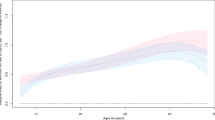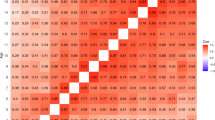Abstract
Background:
Although the negative consequences on health of being obese are well known, most adults gain weight across the lifespan. The general increase in body mass index (BMI) is mainly considered to originate from behavioral and environmental changes; however, few studies have evaluated the influence of these factors on change in BMI in the presence of genetic risk. We aimed to study the influence of multifactorial causes of change in BMI, over 65 years.
Methods and Findings:
Totally, 6130 participants from TwinGene, who had up to five assessments, and 536 from the Swedish Adoption/Twin Study of Aging, who had up to 12 assessments, ranging over 65 years were included. The influence of lifestyle factors, birth cohort, cardiometabolic diseases and an individual obesity genetic risk score (OGRS) based on 32 single nucleotide polymorphisms on change in BMI was evaluated with a growth model. For both sexes, BMI increased from early adulthood to age of 65 years, after which the increase leveled off; BMI declined after age of 80 years. A higher OGRS, birth after 1925 and cardiometabolic diseases were associated with higher average BMI and a steeper increase in BMI prior to 65 years of age. Among men, few factors were identified that influence BMI trajectories in late life, whereas for women type 2 diabetes mellitus and dementia were associated with a steeper decrease in BMI after the age of 65 years.
Conclusions:
There are two turning points in BMI in late adulthood, one at the age of 65 years and one at the age 80 years. Factors associated with an increase in BMI in midlife were not associated with an increase in BMI after the age of 65 years. These findings indicate that the causes and consequences of change in BMI differ across the lifespan. Current health recommendations need to be adjusted accordingly.
This is a preview of subscription content, access via your institution
Access options
Subscribe to this journal
Receive 12 print issues and online access
$259.00 per year
only $21.58 per issue
Buy this article
- Purchase on Springer Link
- Instant access to full article PDF
Prices may be subject to local taxes which are calculated during checkout



Similar content being viewed by others
References
Kopelman PG . Obesity as a medical problem. Nature 2000; 404: 635–643.
Silventoinen K, Kaprio J . Genetics of tracking of body mass index from birth to late middle age: evidence from twin and family studies. Obes Facts 2009; 2: 196–202.
Morrison AC, Bare LA, Chambless LE, Ellis SG, Malloy M, Kane JP et al. Prediction of coronary heart disease risk using a genetic risk score: the Atherosclerosis Risk in Communities Study. Am J Epidemiol 2007; 166: 28–35.
Knopman DS, Edland SD, Cha RH, Petersen RC, Rocca WA . Incident dementia in women is preceded by weight loss by at least a decade. Neurology 2007; 69: 739–746.
Somes GW, Kritchevsky SB, Shorr RI, Pahor M, Applegate WB . Body mass index, weight change, and death in older adults. Am J Epidemiol 2002; 156: 132–138.
Magnusson PK, Almqvist C, Rahman I, Ganna A, Viktorin A, Walum H et al. The Swedish Twin Registry—establishment of a biobank and other recent developments. Twin Res Hum Gen 2013; 16: 317–329.
Finkel D, Pedersen N . Processing speed and longitudinal trajectories of change for cognitive abilities: the Swedish adoption/twin study of aging. Aging Neurpsych Cogn 2004; 11: 325–345.
Broad Institute. NP Annotation and Proxy Search. (accessed 5 May 2012).
Speliotes EK, Willer CJ, Berndt SI, Monda KL, Thorleifsson G, Jackson AU et al. Association analyses of 249,796 individuals reveal 18 new loci associated with body mass index. Nat Genet 2010; 42: 937–948.
Purcell S, Neale B, Todd-Brown K, Thomas L, Ferreira MAR, Bender D et al. PLINK: a toolset for whole-genome association and population-based linkage analysis. Am J Hum Gene 2007; 81: 559–575.
Dahl A, Hassing LB, Fransson E, Berg S, Gatz M, Reynolds CA et al. Being overweight in midlife is associated with lower cognitive ability and steeper cognitive decline in late life. J Gerontol A Biol Sci Med Sci 2010; 65: 57–62.
Muthén LK, Muthén BO . Mplus User’s Guide 6th edn Muthén & Muthén: Los Angeles, 1998-2010.
Raudenbush SW, Bryk AS . Hierarchical Linear Models: Applications and Data Analysis Methods 2nd edn Sage: Newbury Park, CA, USA, 2002.
Dahl AK, Reynolds CA . Accuracy of recalled body weight—a study with 20-years of follow-up. Obesity 2013; 21: 1293–1298.
Dahl AK, Hassing LB, Fransson EI, Pedersen NL . Agreement between self-reported and measured height, weight and body mass index in old age-a longitudinal study with 20 years of follow-up. Age Ageing 2010; 39: 445–451.
SAS Institute Inc. SAS system for Microsoft Windows. In. 9.1 ed: SAS Institute Inc. 2002-2003.
McArdle JJ, Nesselroade JR . Growth curve analysis in contemporary psychological research. In: Schinka J, Velicer W (eds) Comprehensive Handbook of Psychology 2. Wiley: New York, NY, USA pp 447–480 2003.
Dey DK, Rothenberg E, Sundh V, Bosaeus I, Steen B . Height and body weight in the elderly: a 25-year longitudinal study of a population aged 70 to 95 years. Eur J Nutr 1999; 53: 905–914.
Corrada MM, Kawas CH, Mozaffar F, Paganini-Hill A . Association of body mass index and weight change with all-cause mortality in the elderly. Am J Epidemiol 2006; 163: 938–949.
Harrington M, Gibson S, Cottrell RC . A review and meta-analysis of the effect of weight loss on all-cause mortality risk. Nutr Res Rev 2009; 22: 93–108.
Marengoni A, Winblad B, Karp A, Fratiglioni L . Prevalence of chronic diseases and multimorbidity among the elderly population in Sweden. Am J Public Health 2008; 98: 1198–1200.
Dahl AK, Fauth EB, Ernsth-Bravell M, Hassing LB, Ram N, Gerstorf D . Body mass index, change in body mass index, and survival among old and very old persons. J Am Geriatr Soc 2013; 61: 512–518.
Haworth CM, Carnell S, Meaburn EL, Davis OS, Plomin R, Wardle J . Increasing heritability of BMI and stronger associations with the FTO gene over childhood. Obesity (Silver Spring) 2008; 16: 2663–2668.
Belsky DW, Moffitt TE, Houts R, Bennett GG, Biddle AK, Blumenthal JA et al. Polygenic risk, rapid childhood growth, and the development of obesity: evidence from a 4-decade longitudinal study. Arch Pediatr Adolesc Med 2012; 166: 515–521.
Hjelmborg JB, Fagnani C, Silventoinen K, McGue M, Korkeila M, Christensen K et al. Genetic influences on growth traits of BMI: a longitudinal study of adult twins. Obesity (Silver Spring) 2008; 16: 847–852.
Vimaleswaran KS, Angquist L, Hansen RD, van der AD, Bouatia-Naji N, Holst C et al. Association between FTO variant and change in body weight and its interaction with dietary factors: The DiOGenes Study. Obesity 2012; 20: 1669–1674.
Popkin BM, Nielsen SJ . The Sweetening of the world’s diet. Obes Res 2003; 11: 1325–1332.
Kern ML, Reynolds CA, Friedman HS . Predictors of physical activity patterns across adulthood: a growth curve analysis. Pers Soc Psychol Bull 2010; 36: 1058–1072.
Laroche HH, Wallace RB, Snetselaar L, Hillis SL, Cai X, Steffen LM . Weight gain among men and women who have a child enter their home. J Acad Nutr Diet 2013; 113: 1504–1510.
Zajacova A, Ailshire J . Body weight trajectories and mortality among older adults: a joint growth mixture—discrete time survival analysis. Gerontol 2013. e-pub ahead of print 25 January 2013 doi:10.1093/geront/gns164.
Reeves GK, Pirie K, Beral V, Green J, Spencer E, Bull D . Cancer incidence and mortality in relation to body mass index in the Million Women Study: cohort study. BMJ 2007; 335: 1134.
Renehan AG, Tyson M, Egger M, Heller RF, Zwahlen M . Body-mass index and incidence of cancer: a systematic review and meta-analysis of prospective observational studies. Lancet 2008; 371: 569–578.
Moller E, Adami HO, Mucci LA, Lundholm C, Bellocco R, Johansson JE et al. Lifetime body size and prostate cancer risk in a population-based case-control study in Sweden. Cancer Causes Control 2013; 24: 2143–2155.
Murugan AT, Sharma G . Obesity and respiratory diseases. Chronic Respir Dis 2008; 5: 233–242.
Schols AM, Soeters PB, Mostert R, Pluymers RJ, Wouters EF . Physiologic effects of nutritional support and anabolic steroids in patients with chronic obstructive pulmonary disease. A placebo-controlled randomized trial. Am J Respir Crit Care Med 1995; 152: 1268–1274.
Wannamethee SG, Shaper AG . Alcohol, body weight, and weight gain in middle-aged men. Am J Clin Nutr 2003; 77: 1312–1317.
Botoseneanu A, Liang J . The effect of stability and change in health behaviors on trajectories of body mass index in older Americans: a 14-year longitudinal study. J Gerontol A Biol Sci Med Sci 2012; 67: 1075–1084.
Gorber SC, Tremblay M, Moher D, Gorber B . A comparison of direct vs self-report measures for assessing height, weight and body mass index: a systematic review. Obes Rev 2007; 8: 307–326.
Acknowledgements
TwinGene is supported by the Swedish Research Council (M-2005 1112), GenomEUtwin (EU/QLRT-2001-01254; QLG2-CT-2002-01254), NIH DK U01-066134, The Swedish Foundation for Strategic Research (SSF), and the Heart and Lung foundation (no. 20070481). SATSA is supported by the National Institute of Aging (AG04563, AG10175), the MacArthur Foundation Research Network on Successful Aging, the Swedish Council for Working Life and Social Research (FAS) (97:0147:1B and 2009-0795) and the Swedish Research Council (825-2007-7460, 825-2009-6141). Data analyses are supported by FAS 2010-0704, Future Leaders of Aging Research in Europe (FLARE) postdoctoral grant 2010-1852 (AKD) and the European Community’s Seventh Framework Program (FP7/2007-2013; ENGAGE Consortium, grant agreement HEALTH-F4-2007- 201413).
Author Contributions
AKD was responsible for drafting the manuscript. AKD and CAR analyzed the data. AKD, CAR and NLP designed the current study. PKEM and NPL designed, initiated and directed TwinGene. NLP designed, initiated and directed SATSA, and CAR and AKD have directed later waves of data collection of SATSA. TF created the obesity genetic risk scores. All of the authors are responsible for the intellectual content of the manuscript.
Author information
Authors and Affiliations
Corresponding author
Ethics declarations
Competing interests
Tove Fall has received speaker fees from MSD (Merck). The remaining authors declare no conflict of interest.
Additional information
Disclaimer
The funders had no role in study design, data collection and analysis, decision to publish, or preparation of the manuscript.
Rights and permissions
About this article
Cite this article
Dahl, A., Reynolds, C., Fall, T. et al. Multifactorial analysis of changes in body mass index across the adult life course: a study with 65 years of follow-up. Int J Obes 38, 1133–1141 (2014). https://doi.org/10.1038/ijo.2013.204
Received:
Revised:
Accepted:
Published:
Issue Date:
DOI: https://doi.org/10.1038/ijo.2013.204
Keywords
This article is cited by
-
Conversions between metabolically unhealthy and healthy obesity from midlife to late-life
International Journal of Obesity (2024)
-
The dynamic association between body mass index and cognition from midlife through late-life, and the effect of sex and genetic influences
Scientific Reports (2021)
-
Appetite disinhibition rather than hunger explains genetic effects on adult BMI trajectory
International Journal of Obesity (2021)
-
Replicating associations between DNA methylation and body mass index in a longitudinal sample of older twins
International Journal of Obesity (2020)
-
Associations between Dietary Inflammatory Index Scores and Inflammatory Biomarkers among Older Adults in the Lothian Birth Cohort 1936 Study
The Journal of nutrition, health and aging (2019)



